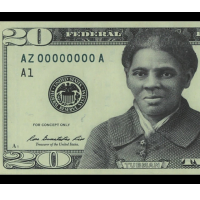The $20 Bill: Andrew Jackson or Harriet Tubman?

With all the talk of taking down statues and changing the names of buildings, isn’t it time that we talk about the presence of Andrew Jackson on the $20 bill?
Jackson, the seventh president of the United States, has been on the front of the $20 bill since 1928, the 100th anniversary of his election.
While other U.S. presidents, such as George Washington ($1 bill) and Thomas Jefferson ($2) owned slaves, Jackson was actually a slave trader who made his fortune buying and selling African-Americans. He regularly beat the slaves he owned, once brutally whipping a woman in public for “putting on airs.” When he moved into the White House in 1829, he brought some of his own slaves with him. In December 1835, Jackson asked Congress to prohibit the Postal Service from circulating anti-slavery material in the South.
What he did to Native Americans was even worse. He forced an estimated 46,000 Native Americans off their ancestral lands and turned over the land to white people. Thousands of Cherokee died on the Trail of Tears, walking to what is now Oklahoma.
In his fifth annual address to Congress in 1833, Jackson said of Native Americans, “They have neither the intelligence, the industry, the moral habits, nor the desire of improvement, which are essential to any favorable change in their condition. Established in the midst of another and superior race, and without appreciating the causes of their inferiority or seeking to control them, they must necessarily yield to the force of circumstances and ere long disappear.”
Despite his extreme and violent racism, Andrew Jackson is still the face of the $20 bill. This has long been a subject of controversy. In 2015, Americans were invited to vote in an unofficial poll to choose a woman to appear on U.S. paper money. Harriet Tubman, an escaped slave who returned to help other slaves escape, won the most votes. On April 20, 2016, Treasury Secretary Jack Lew announced that Tubman would replace Jackson on the front of the $20 bill, but, in a move that can only be described as “wishy-washy,” slave trader and Indian killer Andrew Jackson would be moved to the back side of the $20 bill rather than being bumped off completely. The goal was to have the Tubman $20 bill ready for 2020, the 100th anniversary of the Nineteenth Amendment that guaranteed the right to vote for women.
But then Donald Trump was elected president of the United States. Four days after his inauguration, Trump chose Andrew Jackson’s portrait to be hung in the Oval Office. During the first month of his presidency, Trump toured Jackson’s Tennessee plantation and declared himself “a big fan.” Two months later, Trump’s Secretary of the Treasury, Steve Mnuchin, announced that the project to replace Jackson on the front of the $20 bill with Tubman would be delayed until at least the end of Trump’s presidency.
If Joe Biden is elected president in November, it is possible that Andrew Jackson will finally be removed from the $20 bill and replaced by Harriet Tubman. If this happens, why not put someone other than Jackson on the reverse of the bill? Perhaps Eleanor Roosevelt?
In the meantime, there does exist a rubber stamp that can be purchased or made to cover Jackson’s portrait with one of Tubman. Alternatively, you can print a photo of Tubman and glue it onto a $20 bill.
David Wallechinsky
- Top Stories
- Unusual News
- Where is the Money Going?
- Controversies
- U.S. and the World
- Appointments and Resignations
- Latest News
- Trump to Stop Deportations If…
- Trump Denounces World Series
- What If China Invaded the United States?
- Donald Trump Has a Mental Health Problem and It Has a Name
- Trump Goes on Renaming Frenzy






Comments